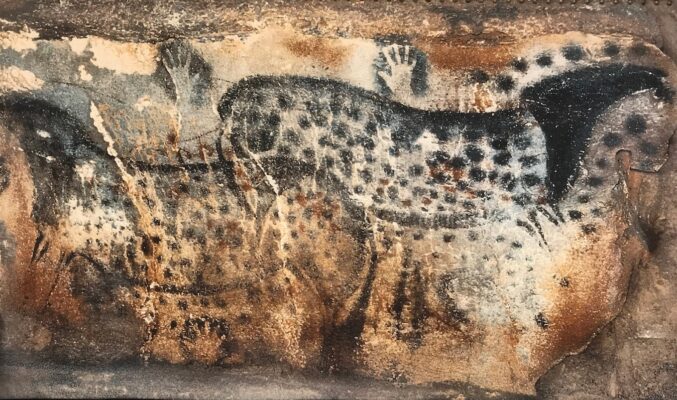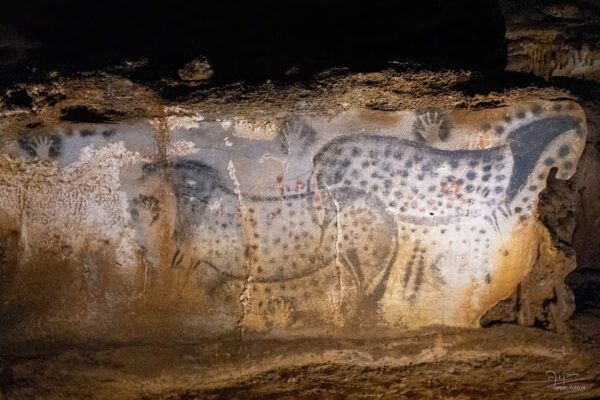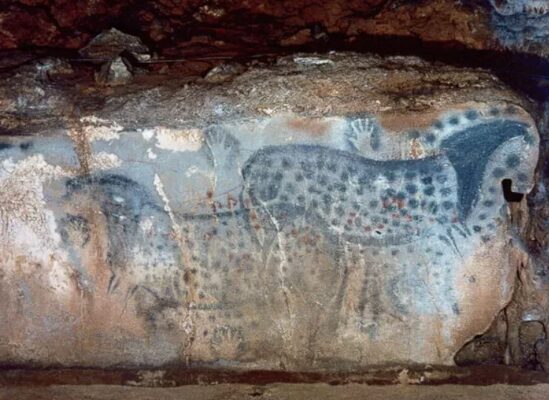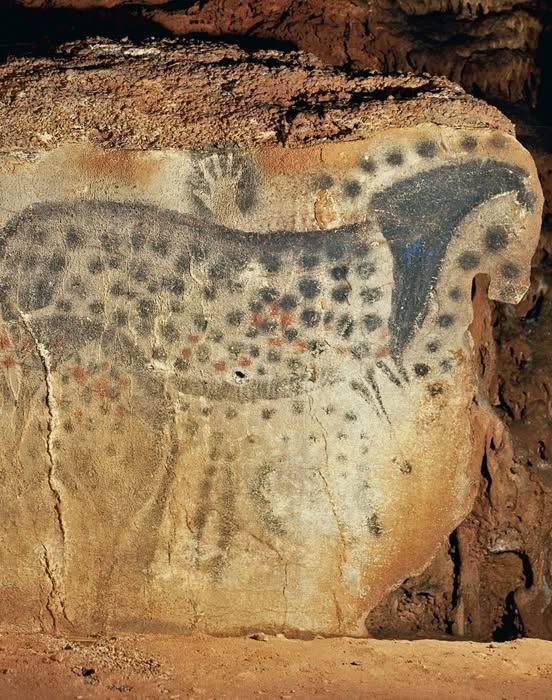The Spotted Horse of Pech Merle is one of the most iconic and well-preserved examples of prehistoric cave art, offering a unique glimpse into the lives and creativity of early humans. Located in southwestern France, the Pech Merle cave system is a treasure trove of ancient artwork, showcasing murals that date back tens of thousands of years. Follow archeology.dulichvn.net to learn more about mysterious artifacts.

1. The Historical Significance of Pech Merle
1.1 One of the Last Accessible Prehistoric Sites
Pech Merle is among the rare prehistoric cave art sites in France that remain open to the public, offering a unique opportunity to step into the past. While many other caves with prehistoric paintings have been closed to protect their delicate environments, Pech Merle stands as a living testament to early human creativity. Visitors can still explore its fascinating chambers and view the remarkable artwork that has endured for millennia, making it a rare and invaluable link to the ancient world. The cave’s accessibility allows for a firsthand experience of the awe-inspiring art created by our distant ancestors.
1.2 Ancient Origins of the Artwork
The captivating murals adorning the walls of Pech Merle date back to the Gravettian period, roughly 25,000 years ago, offering a glimpse into the artistic expressions of early humans. Some of the intricate paintings and engravings found within the cave may have been created during the later Magdalenian era, around 16,000 years ago. This vast timespan underscores the significance of Pech Merle as a living archive of human culture and creativity, preserving the evolution of artistic practices over thousands of years. The cave’s artwork stands as a silent witness to the evolution of human expression, providing invaluable insight into the prehistoric mind.
1.3 Natural Formation of the Caves
The caves of Pech Merle were not only a home for early humans but also a product of the natural forces that shaped the landscape. Long before the arrival of human artists, a powerful underground river carved its way through the region, slowly shaping the caverns over thousands of years. The result is a system of caves that provided shelter for prehistoric communities and a naturally perfect canvas for their artwork. The river’s carving of the rock not only created a safe haven but also created surfaces for early humans to express their thoughts, beliefs, and surroundings through paintings that continue to awe visitors today.

2. The Spotted Horse: An Icon of Prehistoric Art
2.1 A Remarkable Artistic Achievement
The Spotted Horse mural at Pech Merle stands as one of the most extraordinary examples of prehistoric art. The painting vividly depicts two horses, each adorned with distinctive black spots, rendered with remarkable skill and attention to detail. Using natural pigments, the artists blended realism with symbolic elements to capture the essence of these majestic creatures. The precise shading and proportion of the horses demonstrate a sophisticated understanding of form and movement, highlighting the advanced artistic abilities of the creators. This mural is not merely a representation of animals, but a testament to the early humans’ capacity for expression through visual art.
2.2 Symbolism and Purpose
While the exact meaning of the Spotted Horse remains a subject of ongoing speculation, many researchers believe that the artwork held spiritual, ceremonial, or symbolic significance. The deliberate placement of the black spots on the horses, as well as the overall composition of the mural, suggests that it was intended to convey more than a simple depiction of the animals. Some experts theorize that the horses could represent deities, totems, or elements of a shamanic ritual, perhaps linked to the beliefs or practices of the people who created the artwork. This theory is supported by the fact that such paintings were often part of rituals meant to invoke the power of the animals or connect with the spirit world.
2.3 Techniques and Materials
The artists of Pech Merle displayed an impressive level of ingenuity, using natural materials to create their striking images. They employed pigments such as charcoal for black hues, ochre for reds and yellows, and manganese for darker shades. These substances were carefully ground and applied to the cave walls with various tools, including brushes made from animal hair, their hands, or rudimentary implements fashioned from stones and bone.
The use of these materials highlights the resourcefulness of the early artists, who were able to create enduring works of art with the limited tools available to them. This combination of technical skill and creativity speaks to the cultural and artistic sophistication of prehistoric societies.

3. The Legacy and Preservation of Pech Merle
3.1 Insights into Prehistoric Life
The art at Pech Merle provides a rich, invaluable window into the lives of early humans. More than just visually stunning, these murals offer researchers an opportunity to infer important details about the animals that inhabited the region, the natural environment, and the beliefs of the people who created them.
The representations of animals such as horses, bison, and mammoths help to paint a picture of the wildlife in the area, while the deliberate positioning of certain images suggests a complex relationship with the natural world. These artistic expressions, coupled with the cave’s layout, offer crucial insights into the cultural and ritualistic practices of the people, reflecting their connection to nature, spirituality, and their surroundings.
3.2 Conservation Efforts
Given the irreplaceable value of the murals at Pech Merle, significant efforts are made to preserve this prehistoric treasure for future generations. Strict conservation protocols are in place to protect the delicate environment of the cave, ensuring the murals remain intact for centuries to come. Limited visitor access plays a key role in minimizing human impact, while controlled humidity levels and advanced monitoring systems maintain the optimal conditions for preserving the paintings.
Additionally, careful regulation of temperature and air circulation helps prevent the growth of mold or other damaging factors. These conservation efforts ensure that Pech Merle remains an accessible and protected site for both contemporary visitors and future generations of researchers.
3.3 An Enduring Source of Inspiration
Despite being thousands of years old, the murals at Pech Merle continue to captivate and inspire modern audiences. Artists, historians, archaeologists, and visitors alike find themselves drawn to the cave’s powerful blend of natural beauty and ancient creativity. The connection between the prehistoric artists and their work resonates deeply, as it bridges the gap between past and present.
The vivid depiction of animals and the intricate use of natural materials serve as a testament to humanity’s enduring drive for expression and connection. Today, Pech Merle stands not only as a remarkable archaeological site but also as a symbol of the timeless nature of art, offering inspiration and insight into the human spirit that transcends time and culture.
See more: The Incredible Vibrant Opalized Clam Shell: A Stunning Natural Treasure
Conclusion
The Spotted Horse of Pech Merle is a profound symbol of humanity’s early artistic and cultural achievements. This prehistoric masterpiece not only highlights the ingenuity and spiritual depth of our ancestors but also serves as a bridge connecting modern society with its ancient roots. A visit to Pech Merle is a journey back in time, offering a rare opportunity to witness the enduring legacy of prehistoric art.


CÁC TIN KHÁC
Mary Walton: The Forgotten Inventor Who Helped Clean Up America’s Cities
Tomb of Queen Nefertari in the Valley of the Queens, Egypt
Discover the Hypostyle Hall of the Temple of Hathor at Dendera
Venus de Losange: Unveiling the Mystery of a 20,000-Year-Old Paleolithic Icon